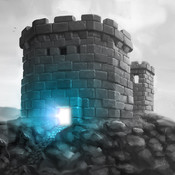You probably remember how last year we here at iFanzine took a look at Eric Kinkead’s QuestLord (our review), a Dungeon Crawler tribute that we met with nothing but adoration and praise. However, there is — to be sure — a very real chance that some of you out there might have been less than thrilled with the app as QuestLord didn’t adhere strictly to all of the genre’s tenets. The game in question didn’t feature a single massive multi-tiered dungeon, pseudo-real time combat, a cadre of heroes to control, or a food system that had to be micromanaged lest everyone ended up starving to death.
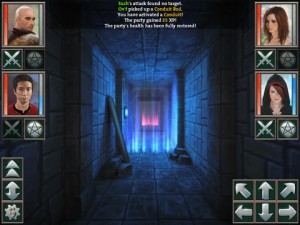 It was precisely for those out there seeking a far more pure Dungeon Crawling experience that the people over at Crescent Moon Games designed their recently released Coldfire Keep (out now, $4.99), which is what our latest review is about to delve into. To be sure, this particular release will definitely give those upset with QuestLord precisely the nostalgic stringency that they desire, yet not with nearly the same level of polish. Although I am loathe to start a review by saying something like this, the fact still remains that far worse things dwell within depths of Coldfire Keep than the many demons that were previously banished there.
It was precisely for those out there seeking a far more pure Dungeon Crawling experience that the people over at Crescent Moon Games designed their recently released Coldfire Keep (out now, $4.99), which is what our latest review is about to delve into. To be sure, this particular release will definitely give those upset with QuestLord precisely the nostalgic stringency that they desire, yet not with nearly the same level of polish. Although I am loathe to start a review by saying something like this, the fact still remains that far worse things dwell within depths of Coldfire Keep than the many demons that were previously banished there.
Speaking of the game’s plot…
Long ago the people of Newsettle were facing down imminent demise at the hands of untold abyssal hordes, or at least they were until a clever wizard — with the help of a knight — devised a scheme to seal all of the monsters in a nearby cave system. The valiant knight carried a powerful Coldfire crystal deep within the labyrinth of tunnels, all while baiting the demonic horde to chase after him, during which time the wizard cast a barrier. His spell — supercharged by the power of the crystal — became an impermeable force that would keep the monsters forever trapped in what became known as Coldfire Keep, or least that had been the plan.
Yet — despite all of that — a long time afterwards some of those monsters still managed to break past the barrier, after which they enacted a great deal of damage upon Newsettle before they finally ran off into the surrounding forest. In response to this a group of fledgling adventurers from the village — including a Fighter, a Rogue, a Shaman, and a Caster — decided to visit the forbidden place, in order to see if more trouble was brewing. What they find is most perplexing: the entire place — by the works of a strange man — has been turned into a dungeon filled with traps and treasures that heroes are dared to explore, and access is granted via a portal rod that can let you slip by the magical barrier.
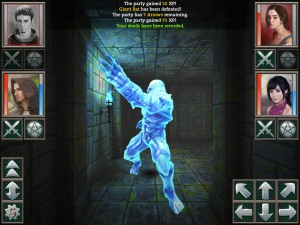 Thusly the quartet — emboldened not only by their promise to Newsettle to learn the truth of what was going on, but also by their desperate need of cash — pick up the magical rod and venture forth past the barrier into the dungeons of Coldfire Keep!
Thusly the quartet — emboldened not only by their promise to Newsettle to learn the truth of what was going on, but also by their desperate need of cash — pick up the magical rod and venture forth past the barrier into the dungeons of Coldfire Keep!
Whereas QuestLord saw people traipsing about the entirety of the Shattered Realm, in Coldfire Keep the player’s entire journey will be relegated purely to the titular dungeon’s many descending layers. In this regard, Coldfire Keep does indeed more strictly follow the single location precedent set forth by famous genre forerunners such as Dungeon Master or Eye of the Beholder. Furthermore, the combat in Coldfire Keep — as another point of interest regarding to the game’s rigid classical adherence — is controlled entirely in real time with some elements of turn based logic thrown on top.
However — before I get into some of the finer points regarding how Coldfire Keep plays — the most important matter of any review is to cover the controls, which is probably also a good entry point for discussing how this game somehow went very wrong. Coldfire Keep begins by presenting you with the choice of three different input schemes for controlling your hero party’s movement: virtual buttons, a physical controller, or motion gestures. While I haven’t personally tested this app with any of the various Bluetooth controllers released for iOS based devices, I am going to assume that this particular method probably produces far better results than the other two do.
First up is Coldfire Keep’s virtual button method of controller input, wherein there exists on screen buttons for: strafing left, strafing right, moving forward, moving backwards, turning left, turning right, and also looking up and down. All of these buttons are very tiny and bunched up tightly together on the bottom lower right-hand corner of your screen, which generally leads to the game commonly misreading your commands. While it’s possible that these buttons were designed with a larger device in mind — such as the iPad — that does little to help everyone else, especially when the gesture method is worse.
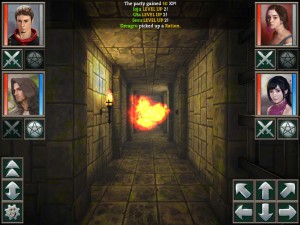 All of the same movement commands listed above are also controllable via various on screen motion gestures, with the primary problem being that — when this input method is selected — the game has an even lower chance of getting most of your inputs correct. Far worse still is that when using this method the game will commonly think that you’re attempting to move when you’re actually trying to interact with aspects of the scenery. This is especially disastrous when the game commonly presents you with timing sensitive puzzles, such as switches placed next to fire spouts that must quickly be manipulated before the trap activates.
All of the same movement commands listed above are also controllable via various on screen motion gestures, with the primary problem being that — when this input method is selected — the game has an even lower chance of getting most of your inputs correct. Far worse still is that when using this method the game will commonly think that you’re attempting to move when you’re actually trying to interact with aspects of the scenery. This is especially disastrous when the game commonly presents you with timing sensitive puzzles, such as switches placed next to fire spouts that must quickly be manipulated before the trap activates.
No matter which of the three movement controls schemes you select, all environmental interactions in Coldfire Keep — not to mention the entirety of the combat system — will be handled in exactly the same manner. In theory object grabbing — as well as scenery manipulating — is handled via simply tapping upon the item in question, but this currently seems to only function whenever the game feels like it. When time isn’t of the essence you’ll commonly find yourself rapidly tapping a single object over and over to someday finally pick it up, and when time does matter you’ll usually find yourself getting burned.
Further complicating this item interaction dilemma will sometimes be the very artwork of Coldfire Keep, which — although impressive to look at — is usually so dark and monochromatic that everything often tends to blend together. It doesn’t help you at all to click on the pull chain that will open a door when the chain itself blends in with the wall behind it, and the same can often be said of various switches and keyholes. Clarity aside, I must reiterate that the fully 3D — yet lock step driven — graphics of Coldfire Keep are very impressive and do a wonderful job of invoking the aesthetic of Dungeon Master.
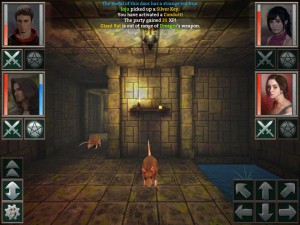 Anyways — movement issues aside — the combat system itself plays out by having you tap either the melee or spell button under each character’s portrait, with certain options being locked out at times based on a character’s class — level — and/or equipment. Once a character has either lashed out — or invoked a spell — their portrait will become grayed out for a period of time, lending the combat its mixture of real-time and turn-based elements. Furthermore — also similar to Dungeon Master — the entire group can move to physically sidestep an oncoming attack, but only if no party members are currently under any form of cool-down (and also only if the dodgy movement controls deign to allow it).
Anyways — movement issues aside — the combat system itself plays out by having you tap either the melee or spell button under each character’s portrait, with certain options being locked out at times based on a character’s class — level — and/or equipment. Once a character has either lashed out — or invoked a spell — their portrait will become grayed out for a period of time, lending the combat its mixture of real-time and turn-based elements. Furthermore — also similar to Dungeon Master — the entire group can move to physically sidestep an oncoming attack, but only if no party members are currently under any form of cool-down (and also only if the dodgy movement controls deign to allow it).
By the way, I hope you’re especially fond of giant rats — and having your ass thoroughly handed to you by said critters — as rodents of unusual sizes will comprise the bulk of what you’ll experience early on. While other monsters do exist — and you will even occasionally run into them — you are going to be encountering a lot of rats all the same, and then watching the fight last forever as everyone continues to miss their target. Unfortunately no where does the game explain what dice rolls are causing you to endlessly fail — or why the rat often succeeds — and so you won’t ever know if the RNG was merely hating you, or if your currently selected weapon had deleterious properties.
This opaqueness into the inner numbers that drive Coldfire Keep’s mechanics will vex you in many other places as well, such as a treasure chest early on where the game asks you to pick its lock. Each time you fail the game will make you wait for 15 system ticks — which aren’t the same as you moving around — before you’re allowed to try again, with you never knowing if bad rolls or stats led to your failure each time. On one game attempt it took me over ten tries — with massive waiting between each attempt — before I could finally get the chest to open, whereas the other time worked on the very first try.
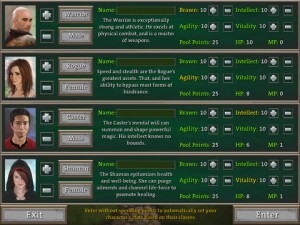 If the game bothered to let me know why I was failing — such as bad overall odds, or merely bad luck with the dice — then I might have been empowered to better plan the stats of my team going into Coldfire Keep. When beginning you will be permitted to choose each hero’s gender — select a portrait — and also determine their profession, after which you will have to deal with how their initial stat points should be distributed. You can either assign these all by yourself, or let them be auto assigned based on their profession, but nothing in-game ever fully explains how the point spread will cause things to change.
If the game bothered to let me know why I was failing — such as bad overall odds, or merely bad luck with the dice — then I might have been empowered to better plan the stats of my team going into Coldfire Keep. When beginning you will be permitted to choose each hero’s gender — select a portrait — and also determine their profession, after which you will have to deal with how their initial stat points should be distributed. You can either assign these all by yourself, or let them be auto assigned based on their profession, but nothing in-game ever fully explains how the point spread will cause things to change.
While some might argue that this lack of in-game hand holding makes Coldfire Keep truer to the originals that it so desperately seeks to imitate, the fact is that those games didn’t need to explain themselves as they provided 500 page manuals to handle that. Without a heavy reference tome by your side to explain the various benefits of a dagger over a cleaver — or what a single point’s difference to a stat will mean — you truly are wandering about in the dark in Coldfire Keep, and this gets old fast. This is particularly annoying when you need for your Rogue to roll successfully in order to find hidden switches, as finding secrets and solving puzzles are paramount to progressing forward.
However — to be fair — Coldfire Keep is still playable, and those seeking a more stringently pure Dungeon Crawler experience will probably be able to ignore these shortcomings and slog through the game all the same. On the up side the game does at least include an auto-map function, rather than expecting players to carry graph paper and a pencil everywhere just in case they decided to play during their lunch break. Yet — as far as everyone else should be concerned — with the price tag of Coldfire Keep being as high as it is, the cheaper QuestLord is still the hands down superior Dungeon Crawling option.
iFanzine Verdict: While Crescent Moon Game’s Coldfire Keep might be far more stringently true to the tenets of ancient Dungeon Crawler classics, at least when compared to the recent QuestLord, the game is still hard to recommend to even purists. With dodgy controls that only sometimes respond — a deleterious deal of opaqueness that leaves you wondering why anything is ever happening — and dark graphics that often get in the way of solving puzzles, what you have here is a very frustrating app. While some truly ardent purists might be able to look past all of these shortcomings and enjoy the heavily old school mechanics, most others will find the cheaper — and far easier to control — QuestLord to be a far more enjoyable retro Dungeon Crawler romp.


